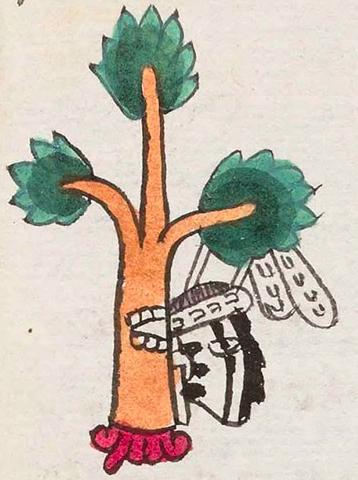Cuauhtitlan (Mdz26r)
This compound glyph for the place name Cuauhtitlan has various visual components, including the cuahuitl), tree, and the tlantli (phonetic indicator for the locative suffix, -tlan, but represented visually as teeth, which is the translation for tlantli). The ligature -ti- does not appear visually. The cuahuitl) has the standard shape and colors, with a leader and two side branches, two-tone green foliage, and bark the color of terracotta. The curling red roots are showing. The teeth consist of both uppers and lowers, and they are embedded in the tree trunk, facing to the viewer's right.
Near the teeth and attached to one of the tree branches, is a human head in profile, looking to our right. The face has black vertical stripes. Also hanging from the branch are what appear to be two long pieces of white, spun cotton.
Stephanie Wood
Frances Berdan and Patricia Anawalt suggest that the head represents "the black and white mask of the goddess Tlazolteotl ('Filth-Deity')," with its "cotton headband with two cotton fillets, a diagnostic characteristic of this goddess (see the Codex Borbonicus 1974:13)." Perhaps this female divine force has a special association with this particular Cuauhtitlan.
The Codex Mendoza has two additional representations of Cuauhtitlan, both involving trees with teeth. Gordon Whittaker (Deciphering Aztec Hieroglyphs, 2021, 102) has discovered that the full set of teeth (top and bottom) are often used, as here, when there is a ligature (-ti-) before the locative suffix -tlan, resulting in -titlan. This example supports the case. Advanced searches for glyphs ending in -tlan and ending in -titlan will provide data showing a somewhat mixed result, but there is a tendency toward what Whittaker suggests.
It is worth noting that this place name uses the -titlan postposition on the stem that once had the -tl absolutive (cuahuitl, tree). Whereas, the place name Cuauhtlan uses the -tlan postposition on the stem that once had the -tli absolutive (cuauhtli, eagle).
Stephanie Wood
quauhtitlan. puo
Cuauhtitlan, pueblo
Stephanie Wood
c. 1541, or by 1553 at the latest
Stephanie Wood
trees, árboles, teeth, dientes, deidades, deities, goddesses, diosas, algodón, Quauhtitlan, nombres de lugares

cuahui(tl), tree, https://nahuatl.wired-humanities.org/content/cuahuitl-1
tlan(tli), tooth/teeth, https://nahuatl.wired-humanities.org/content/tlantli
-tlan (locative suffix), by, near, among, https://nahuatl.wired-humanities.org/content/tlan
"Below the Trees" or "Among the Trees" [Frances Karttunen, unpublished manuscript, used here with her permission.] Elsewhere she also suggested "Adjacent to Woodland." See her book, An Analytical Dictionary of Nahuatl (Norman: University of Oklahoma Press, 1992), 64.
"Near the Trees" (Berdan and Anawalt, 1992, vol. 1, p. 202)
Codex Mendoza, folio 26 recto, https://digital.bodleian.ox.ac.uk/objects/2fea788e-2aa2-4f08-b6d9-648c00..., image 62 of 188.
The Bodleian Libraries, University of Oxford, hold the original manuscript, the MS. Arch. Selden. A. 1. This image is published here under the UK Creative Commons, “Attribution-NonCommercial-ShareAlike 3.0 License” (CC-BY-NC-SA 3.0).





